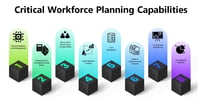Workforce planning is crucial to managing organizational resources, but getting accurate and up-to-date information on workforce needs, costs, and performance can be challenging. Workforce planning is a complex and dynamic process, and an accurate plan requires granular data and a comprehensive understanding of source data, drivers, assumptions, and business rules.
Let’s review critical workforce planning capabilities or areas:
The first capability is a real-time data integration and master data management to automatically import and manage data from various data sources: Human Resources, Finance, and Operational Systems.
Driver-based planning is a critical capability in workforce planning. It helps to effectively manage and apply global drivers, assumptions, and calculation rules.
Effective workforce planning requires managing micro-level drivers and position-level data by a central office or workflow that allows stakeholders at all levels to collaborate on their portions of the plan while maintaining security access requirements. It enables organizations to gain insight and rationale into key business drivers that require an increase or decrease in headcount and costs over a defined period.
Accurate labor rates are critical for workforce planning as they assist with costing and cost allocations. Labor rates provide information on how much additional resources cost the organization, which is essential for budgeting and financial forecasting. It can be difficult to accurately forecast your current and future hiring capabilities or workforce reduction savings without reliable labor rates.
An effective budget makes use of a well-developed cost-allocation plan that can help shift costs to specific business activities, business units, programs, projects, grants, and other elements. Organizations need the capability to automate complex cost allocations using a flexible, transparent, and auditable framework specific to each organization.
What-if scenarios and versions are an essential aspect of workforce planning. They allow organizations to simulate different scenarios and see the impact on their workforce and budget. A built-in versioning capability to compare different what-if scenarios on the fly can help organizations identify the most cost-effective and efficient workforce plan and make more informed decisions.
Current-year projections are an important aspect of workforce planning as they help organizations streamline their projections process and improve accuracy by integrating actuals, budgeted, and forecasted resource needs. This provides a more accurate picture of the organization's workforce requirements for the current year and enables better decision-making.
The final important capability is the on-demand availability of analytical views, reports, and dashboards. Using real-time data in this process allows organizations to make more informed decisions and respond quickly to changes in the workforce landscape.
At Neubrain, we specialize in providing workforce planning solutions that help organizations better understand and manage their workforce, including tools for data analysis, budgeting, and forecasting, as well as support for collaboration and communication between different departments. Organizations in various industries leverage our workforce panning solutions to increase accuracy, provide visibility into important drivers, reduce cycle time, and enable fast decision-making to take corrective steps promptly.

Learn how the Neubrain Workforce Planning Solution can drastically improve the capability to accurately budget and forecast the most valuable strategic asset – the workforce.








